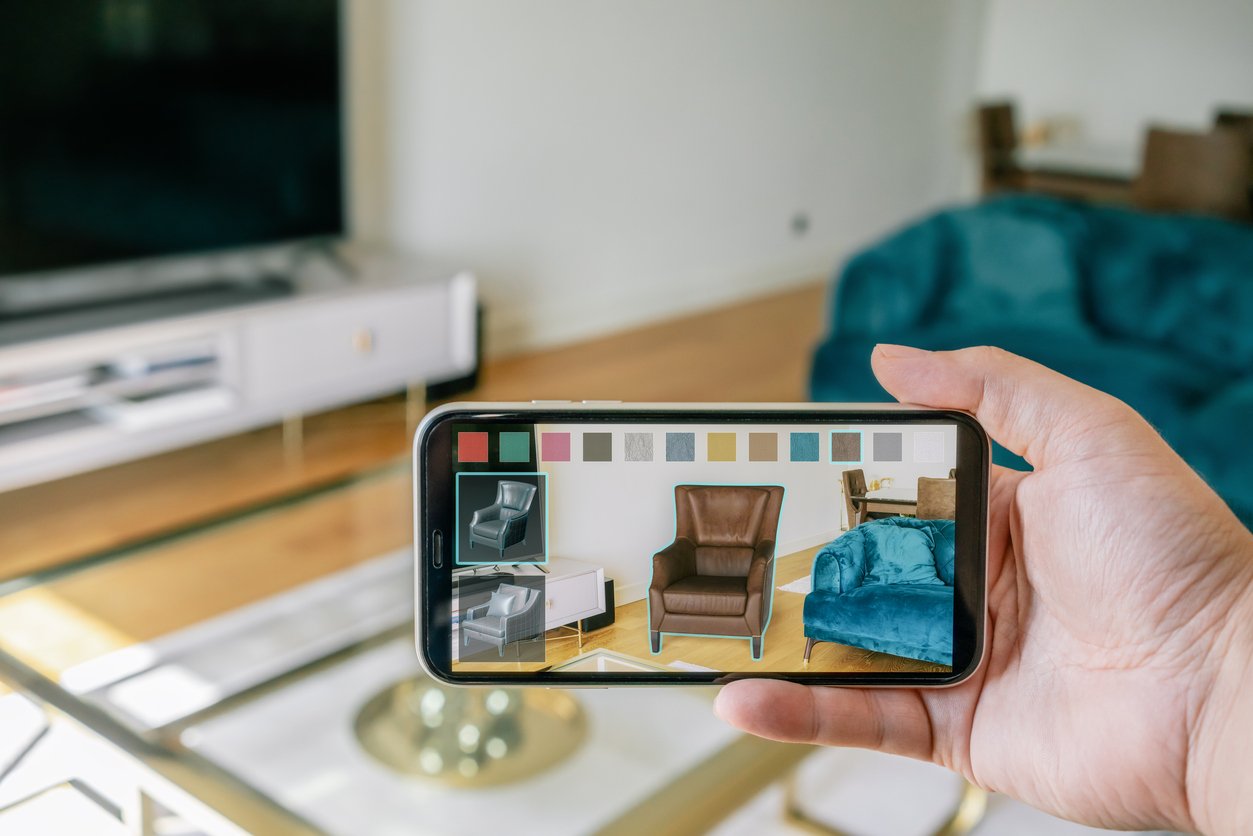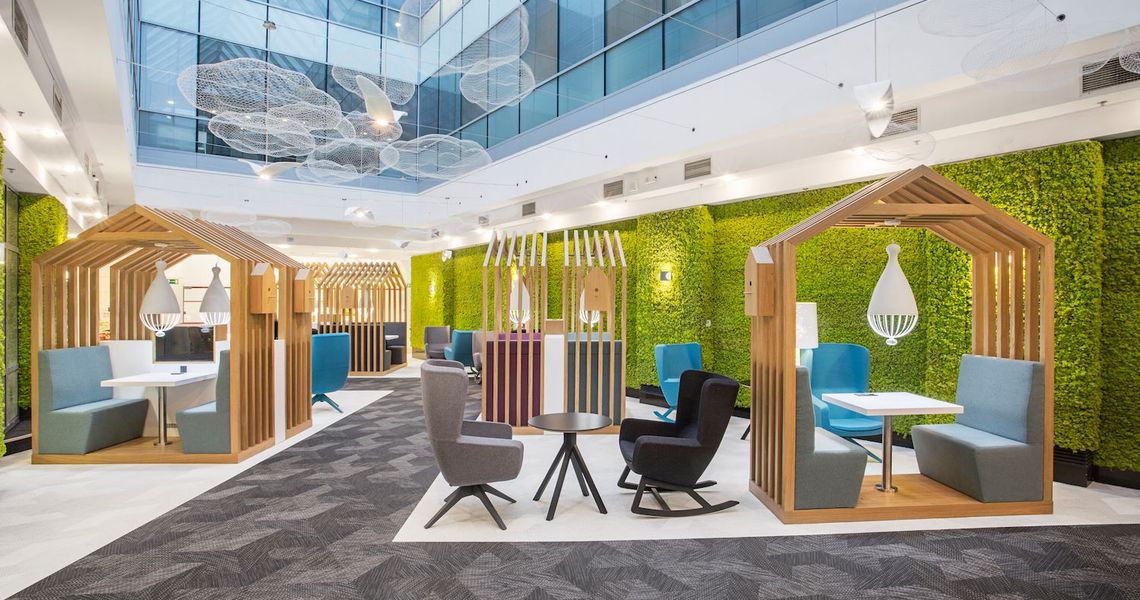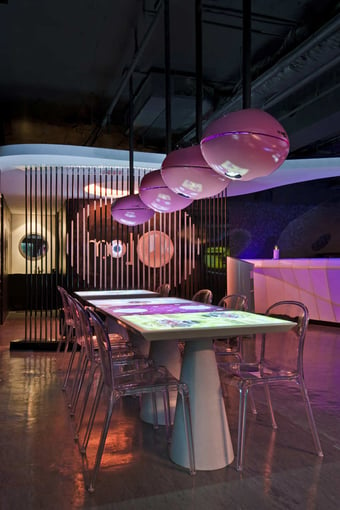Updated December 2025
The interior design industry is constantly changing and evolving. Every year brings a fresh crop of trends—some are just passing fads, while others completely alter the way we think about creating spaces.
Are you just beginning your interior design training? This is a very exciting time to enter the industry. There is so much new technology and innovation in design…the field is almost unrecognizable from what it was just a few years ago.
And that brings us to the topic of this post: the intersection of interior design and technology. Keep reading to explore the digital tools and trends that are reshaping the way interior spaces are conceived, designed, and experienced.
TABLE OF CONTENTS
DIGITAL TOOLS
Digital tools are enhancing the interior design process in a number of ways.
Augmented Reality
Augmented reality (AR) involves overlaying images or animations onto the real-world environment. It merges the virtual and physical worlds, allowing designers and clients to visualize how design elements will integrate into their existing spaces.
Companies like IKEA, Wayfair, and Houzz offer AR apps that make it easy for prospective customers to try out different products virtually and see how they would fit in their homes. You simply scan the room with your smartphone’s camera; the app then overlays a 3D rendering of the sofa, table, or other item you choose. The latest version of IKEA’s app, called IKEA Kreativ, even lets you remove existing items and replace them with IKEA products.
As a designer, you can use these digital interior design tools to experiment with styles and layouts and get immediate client feedback.
 Innovative home design tech like AR apps are making it simple for clients to test out a designer’s vision
Innovative home design tech like AR apps are making it simple for clients to test out a designer’s vision
Virtual Reality
While augmented reality allows users to visualize furniture or design changes within their existing physical space, virtual reality (VR) creates a completely immersive, computer-generated environment. VR takes 3D interior modelling to a whole new level, enabling users to experience and interact with a simulated space. Wearing a headset, you can look around a kitchen or bedroom and see the furnishings and other design elements from multiple angles, as if you were standing in that room.
Virtual reality in interior design is fundamentally reshaping client presentations and design modifications. VR allows you to do a virtual walkthrough and get a realistic sense of scale, proportion, and spatial dynamics. You get to test the functionality and esthetic appeal of a particular concept and your clients get a truer sense of what the completed room will be like.
AI and Automation
Artificial intelligence (AI) and automation have significantly increased the efficiency of interior design processes. AI algorithms can analyze vast amounts of data, helping designers identify trends, predict preferences, and suggest design elements based on user behaviour. This data-driven approach allows you to tailor your creations to the specific tastes and needs of your clients, providing a more personalized design experience.
AI can also help with the more mundane aspects of interior design. Automation can make scheduling and data entry a breeze, for example. Floor plans and 3D models can be created in a fraction of the time. That frees you up to focus on more creative aspects of your work.
SMART HOME TECHNOLOGY
Modern interiors are increasingly taking advantage of smart home features like:
IoT Devices
Interior designers are incorporating Internet of Things (IoT) devices seamlessly into their designs, creating smart and connected living spaces. This integration allows for greater control and customization of various elements within a home, such as lighting, temperature, and security.
For instance, smart thermostats can learn user preferences and adjust the temperature accordingly, resulting in an energy-efficient design and a comfortable environment. Automated window treatments can be controlled based on factors like time of day, weather conditions, or user preferences. Smart lighting systems can adapt to different moods and activities, enhancing the overall ambience of a space.
With IoT devices, you can bring various elements together to create a smart, responsive, and energy-conscious living space.
Advanced Lighting Systems
Advanced lighting systems, often integrated with IoT, offer designers the ability to create dynamic lighting schemes that enhance the mood and functionality of a space.
You’re not limited to traditional lights with one on/off switch. Advanced systems use sensors to allow lights to respond to natural light and room occupancy levels. Smart lighting systems can also be programmed to adapt to different activities, such as working (when you’d want cool white light to keep you alert) or relaxing (when you’d want warmer light to prepare for sleep).
Researchers are even experimenting with leveraging the light produced by living organisms. French company Glowee is using cylindrical tubes containing bioluminescent bacteria to provide a soft blue glow in public spaces. The light requires virtually no energy and releases no heat. While such technology is not yet ready for large-scale use, Glowee believes it can lead to a more energy-efficient way of lighting our cities.
 Glowee is developing lighting products that utilize the glow from bioluminescent bacteria. Image source: Glowee
Glowee is developing lighting products that utilize the glow from bioluminescent bacteria. Image source: Glowee
SUSTAINABLE DESIGN MATERIALS
Sustainable materials play a significant role in tech-forward interior design by aligning with the principles of eco-consciousness, resource efficiency, and responsible manufacturing.
3D Printed Elements
The advent of 3D printing technology has revolutionized the manufacturing of interior design elements. 3D printed furniture, lighting fixtures, and decorative elements not only showcase unique designs but also contribute to sustainable practices by minimizing material waste. In this form of manufacturing, you create an item layer by layer rather than cutting it from larger material, so you only use what you actually need.
You can create 3D printed items from eco-friendly interior materials like wood waste, recycled plastic, or plant-based resins.
 This table has a 3D printed base. The stools were printed from compounded sawdust generated from milling the table. Image source: Mebl
This table has a 3D printed base. The stools were printed from compounded sawdust generated from milling the table. Image source: Mebl
Innovative Materials
Sustainable design innovations include using materials like:
- Bamboo: A fast-growing grass that can be used for flooring, furniture, and decorative elements
- Cork: A renewable and biodegradable material that can be used for flooring, wall coverings, and furniture
- Reclaimed wood: Salvaged or reclaimed wood from old buildings, barns, or shipping pallets gives a rustic character to furniture and accent pieces
- Wool: A natural and renewable fibre that can be used for carpets, rugs, and upholstery
- Recycled metal: Scrap metal such as aluminum, copper, or steel can be repurposed for light fixtures, furniture, and decorative items
- Recycled plastic: Plastic waste can be transformed into furniture, rugs, and décor items
- Moss: Stabilized moss can be used to create natural wall panels that require no maintenance, light, or water
 Moss wall in the Wola Park shopping centre in Warsaw, Poland (Image: Verde Profilo)
Moss wall in the Wola Park shopping centre in Warsaw, Poland (Image: Verde Profilo)
INTERACTIVE INTERIOR DESIGN
Interactive interior design is all about incorporating technology and user engagement. For instance, smart textiles with sensors and actuators can create responsive surfaces that react to user interactions. Walls or furniture covered in these textiles can change texture or shape based on user touch or movement.
Some designers are also using projection mapping technology to turn walls or tables into interactive displays. At the MoJo Cuisine restaurant in Taiwan, touch sensors and an overhead installation allow diners to use the table surface to order food, play games, pay their bill, and even leave comments.

Interactive table at MoJo Cuisine restaurant in Taiwan. Image source: ArchDaily
LEARN MORE ABOUT INTERIOR DESIGN AND TECHNOLOGY
Explore the 18-month interior design training from Herzing College. This online program includes instruction on the latest interior design techniques and software programs. It also includes an eight-week internship.
Click below to browse the program and course list for yourself. Request information by email or chat live with an admissions advisor. We’re here to help!







